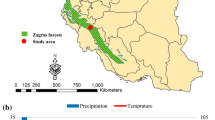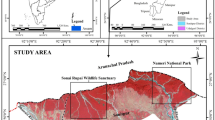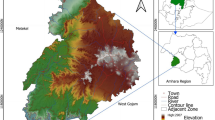Abstract
Loss of forest cover has an important impact on global climate change. This study investigated variation in forest cover in Luang Prabang district, the capital of Luang Prabang province, Lao PDR, using Landsat Thematic Mapper (TM) and Operational Land Imager (OLI) satellite imagery over the period 1988–2021. The maximum likelihood classification technique was used to classify Landsat images of the years 1988, 2001, 2011, and 2021 and was evaluated for accuracy using the kappa coefficient for each year (0.860, 0.869, 0.878, and 0.950, respectively). The potential of classification based on the Normalized Difference Vegetation Index (NDVI) and Soil Adjusted Vegetation Index (SAVI) to detect changes in natural forest and cultivated forest cover compared with supervised classification was also evaluated. The natural forest cover of the study area was estimated at 84.09% (687.82 km2) of the total land area in 1988. This number decreased to 56.93% (465.69 km2) in 2001 and subsequently increased to 60.85% (497.77 km2) in 2011 and 66.49% (543.92 km2) in 2021. Cultivated forest cover in 1988 was 4.96% (40.58 km2) and increased to 16.84% (137.76 km2) in 2001, however it decreased to 13.57% (110.97 km2) in 2011 and 9.67% (79.10 km2) in 2021. Severely reduced forest cover is often associated with the expansion of agriculture on the forest edge. Logging and charcoal production are other problems that contribute to the reduction of forest cover. Overall, our results show the necessity of forest management, rational land-use planning policy, and increased community awareness of conservation and sustainable development of forest resources in the study area in the future.









Similar content being viewed by others
Data Availability
The data used to support the findings of this study are available from the corresponding author upon reasonable request.
References
Anderson, J. R., Hardy, E. E., Roach, J. T., & Witmer, R. E. (1976). A land use and land cover classification system for use with remote sensor data. In Geological Survey Professional Paper, U.S. (Vol. 964, pp. 1–28). Government Printing Office.
Austin, K. G., Schwantes, A., Gu, Y., & Kasibhatla, P. S. (2019). What causes deforestation in Indonesia? Environmental Research Letters, 14(2), 024007. https://doi.org/10.1088/1748-9326/aaf6db
Bakr, N., Weindorf, D. C., Bahnassy, M. H., Marei, S. M., & El-Badawi, M. M. (2010). Monitoring land cover changes in a newly reclaimed area of Egypt using multi-temporal Landsat data. Applied Geography, 30(4), 592–605. https://doi.org/10.1016/j.apgeog.2009.10.008
Butt, A., Shabbir, R., Ahmad, S. S., & Aziz, N. (2015). Land use change mapping and analysis using Remote Sensing and GIS: A case study of Simly watershed, Islamabad, Pakistan. The Egyptian Journal of Remote Sensing and Space Science, 18(2), 251–259. https://doi.org/10.1016/j.ejrs.2015.07.003
Chakraborty, A., Seshasai, M. V. R., Reddy, C. S., & Dadhwal, V. K. (2018). Persistent negative changes in seasonal greenness over different forest types of India using MODIS time series NDVI data (2001–2014). Ecological Indicators, 85, 887–903. https://doi.org/10.1016/j.ecolind.2017.11.032
Chowdhury, M., Hasan, M. E., & Abdullah-Al-Mamun, M. M. (2020). Land use/land cover change assessment of Halda watershed using remote sensing and GIS. The Egyptian Journal of Remote Sensing and Space Science, 23(1), 63–75. https://doi.org/10.1016/j.ejrs.2018.11.003
Clark, S., Bolt, K., & Campbell, A. (2008). Protected areas: an effective tool to reduce emissions from deforestation and forest degradation in developing countries. UNEP-WCMC.
Congalton, R. G. (1991). A review of assessing the accuracy of classifications of remotely sensed data. Remote Sensing of Environment, 37(1), 35–46. https://doi.org/10.1016/0034-4257(91)90048-B
Dan, K. O., David, P. K., Pierre, N. L. J., & Chérif, A. Y. (2018). Analysis of the Causes of Deforestation and Degradation of the Forest of Katako Village. Elixir Environment and Forestry, 123(2018), 51945–51948.
Disperati, L., & Virdis, S. G. P. (2015). Assessment of land-use and land-cover changes from 1965 to 2014 in Tam Giang-Cau Hai Lagoon, central Vietnam. Applied Geography, 58, 48–64. https://doi.org/10.1016/j.apgeog.2014.12.012
Faruque, M. J., Vekerdy, Z., Hasan, M. Y., Islam, K. Z., Young, B., Ahmed, M. T., Monir, M. U., Shovon, S. M., Kakon, J. F., & Kundu, P. (2022). Monitoring of land use and land cover changes by using remote sensing and GIS techniques at human-induced mangrove forests areas in Bangladesh. Remote Sensing Applications: Society and Environment, 25, 100699. https://doi.org/10.1016/j.rsase.2022.100699
Food and Agriculture Organization [FAO]. (2018). The State of the World’s Forests 2018—Forest Pathways to Sustainable Development.
Gao, J., & Liu, Y. (2010). Determination of land degradation causes in Tongyu County, Northeast China via land cover change detection. International Journal of Applied Earth Observation and Geoinformation, 12(1), 9–16. https://doi.org/10.1016/j.jag.2009.08.003
Hansen, M. C., Potapov, P. V., Moore, R., Hancher, M., Turubanova, S. A., Tyukavina, A., Thau, D., Stehman, S. V., Goetz, S. J., Loveland, T. R., Kommareddy, A., Egorov, A., Chini, L., Justice, C. O., & Townshend, J. (2013). High-resolution global maps of 21st-century forest cover change. Science, 342(6160), 850–853. https://doi.org/10.1126/science.1244693
Hasan, M. E., Nath, B., Sarker, A. R., Wang, Z., Zhang, L., Yang, X., Nobi, M. N., Røskaft, E., Chivers, D. J., & Suza, M. (2020). Applying multi-temporal Landsat satellite data and markov-cellular automata to predict forest cover change and forest degradation of Sundarban reserve forest, Bangladesh. Forests, 11(9), 1016. https://doi.org/10.3390/f11091016
Hosonuma, N., Herold, M., De Sy, V., De Fries, R. S., Brockhaus, M., Verchot, L., Angelsen, A., & Romijn, E. (2012). An assessment of deforestation and forest degradation drivers in developing countries. Environmental Research Letters, 7(4), 044009. https://doi.org/10.1088/1748-9326/7/4/044009
Hossain, K. T., Tanim, I. A., & Salauddin, M. (2016). Change detection of forest cover: a study Nijhum Dwip National Park, Hatiya, Noakhali. Journal of Life and Earth Sciences, Jagannath University, 2(2), 54–90.
Huete, A. R. (2012). Vegetation indices, remote sensing and forest monitoring. Geography Compass, 6(9), 513–532. https://doi.org/10.1111/j.1749-8198.2012.00507.x
Iqbal, M. F., & Khan, I. A. (2014). Spatiotemporal land use land cover change analysis and erosion risk mapping of Azad Jammu and Kashmir, Pakistan. The Egyptian Journal of Remote Sensing and Space Science, 17(2), 209–229. https://doi.org/10.1016/j.ejrs.2014.09.004
Islam, M. S. (2021). Assessing the dynamics of land cover and shoreline changes of Nijhum Dwip (Island) of Bangladesh using remote sensing and GIS techniques. Regional Studies in Marine Science, 41, 101578. https://doi.org/10.1016/j.rsma.2020.101578
Jensen, J. R. (1996). Introductory digital image processing: a remote sensing perspective (2nd ed.). Prentice-Hall Inc..
Kabir, M. A., Salauddin, M., Hossain, K. T., Tanim, I. A., Saddam, M. M. H., & Ahmad, A. U. (2020). Assessing the shoreline dynamics of Hatiya Island of Meghna estuary in Bangladesh using multiband satellite imageries and hydro-meteorological data. Regional Studies in Marine Science, 35, 101167. https://doi.org/10.1016/j.rsma.2020.101167
Lea, C., & Curtis, A. C. (2010). Thematic accuracy assessment procedures: National Park Service vegetation inventory, version 2.0. Natural resource report NPS/2010/NRR—2010/204. National Park Service.
Liang, L., Chen, F., Shi, L., & Niu, S. (2018). NDVI-derived forest area change and its driving factors in China. PloS One, 13(10), e0205885. https://doi.org/10.1371/journal.pone.0205885
Lu, D., Moran, E., Hetrick, S., & Li, G. (2011). Land-use and land-cover change detection. Advances in environmental remote sensing sensors, algorithms, and applications (pp. 273–290). CRC Press Taylor & Francis Group.
Manandhar, R., Odeh, I. O., & Ancev, T. (2009). Improving the accuracy of land use and land cover classification of Landsat data using post-classification enhancement. Remote Sensing, 1(3), 330–344. https://doi.org/10.3390/rs1030330
Matsushita, B., Yang, W., Chen, J., Onda, Y., & Qiu, G. (2007). Sensitivity of the enhanced vegetation index (EVI) and normalized difference vegetation index (NDVI) to topographic effects: a case study in high-density cypress forest. Sensors, 7(11), 2636–2651. https://doi.org/10.3390/s7112636
Ministry of Agriculture and Forestry. (2010). Fourth National Report to the Convention on Biological Diversity.
MoNRE, I. U. C. N. (2016). Fifth national report to the united nations convention on biological diversity–DFRM-MoNRE and Technical support .
Mubako, S., Belhaj, O., Heyman, J., Hargrove, W., & Reyes, C. (2018). Monitoring of land use/land-cover changes in the arid transboundary middle Rio grande basin using remote sensing. Remote Sensing, 10(12), 2005. https://doi.org/10.3390/rs10122005
Muhati, G. L., Olago, D., & Olaka, L. (2018). Land use and land cover changes in a sub-humid Montane forest in an arid setting: A case study of the Marsabit forest reserve in northern Kenya. Global Ecology and Conservation, 16, e00512. https://doi.org/10.1016/j.gecco.2018.e00512
Nagendra, H. (2008). Do parks work? Impact of protected areas on land cover clearing. AMBIO: A Journal of the Human Environment, 37(5), 330–337. https://doi.org/10.1579/06-R-184.1
Owojori, A., & Xie, H. (2005). Landsat image-based LULC changes of San Antonio, Texas using advanced atmospheric correction and object-oriented image analysis approaches. In In 5th International Symposium on Remote Sensing of Urban Areas.
Pesaresi, S., Mancini, A., Quattrini, G., & Casavecchia, S. (2020). Mapping mediterranean forest plant associations and habitats with functional principal component analysis using Landsat 8 NDVI time series. Remote Sensing, 12(7), 1132. https://doi.org/10.3390/rs12071132
Provincial Statistics Center. (2018). Luang Prabang province Statistical Year Book, 2018. Retrieved November 2022, from https://laosis.lsb.gov.la
Samndong, R. A., Bush, G., Vatn, A., & Chapman, M. (2018). Institutional analysis of causes of deforestation in REDD+ pilot sites in the Equateur province: Implication for REDD+ in the Democratic Republic of Congo. Land Use Policy, 76, 664–674. https://doi.org/10.1016/j.landusepol.2018.02.048
Shivakumar, B. R., & Rajashekararadhya, S. V. (2018). Investigation on land cover mapping capability of maximum likelihood classifier: a case study on North Canara, India. Procedia Computer Science, 143, 579–586. https://doi.org/10.1016/j.procs.2018.10.434
Spadoni, G. L., Cavalli, A., Congedo, L., & Munafò, M. (2020). Analysis of Normalized Difference Vegetation Index (NDVI) multi-temporal series for the production of forest cartography. Remote Sensing Applications: Society and Environment, 20, 100419. https://doi.org/10.1016/j.rsase.2020.100419
Thakur, S., Maity, D., Mondal, I., Basumatary, G., Ghosh, P. B., Das, P., & De, T. K. (2021). Assessment of changes in land use, land cover, and land surface temperature in the mangrove forest of Sundarbans, northeast coast of India. Environment, Development and Sustainability, 23, 1917–1943. https://doi.org/10.1007/s10668-020-00656-7
Thien, B. B., & Phuong, V. T. (2023). Using Landsat satellite imagery for assessment and monitoring of long-term forest cover changes in Dak Nong province, Vietnam. Geographica Pannonica, 27(1), 69–82. https://doi.org/10.5937/gp27-41813
Thien, B. B., Phuong, V. T., & Huong, D. T. (2023). Detection and assessment of the spatio-temporal land use/cover change in the Thai Binh province of Vietnam’s Red River delta using remote sensing and GIS. Modeling Earth Systems and Environment, 9(2), 2711–2722. https://doi.org/10.1007/s40808-022-01636-8
Truong, N. C. Q., Nguyen, H. Q., & Kondoh, A. (2018). Land use and land cover changes and their effect on the flow regime in the upstream Dong Nai River Basin, Vietnam. Water, 10(9), 1206. https://doi.org/10.3390/w10091206
Tsutsumida, N., & Comber, A. J. (2015). Measures of spatio-temporal accuracy for time series land cover data. International Journal of Applied Earth Observation and Geoinformation, 41, 46–55. https://doi.org/10.1016/j.jag.2015.04.018
Tyukavina, A., Baccini, A., Hansen, M. C., Potapov, P. V., Stehman, S. V., Houghton, R. A., Krylov, A. M., Turubanova, S., & Goetz, S. J. (2015). Aboveground carbon loss in natural and managed tropical forests from 2000 to 2012. Environmental Research Letters, 10(7), 074002. https://doi.org/10.1088/1748-9326/10/7/074002
United Nations Educational, & Scientific and Cultural Organization (UNESCO). (1995). Convention concerning the protection of the world cultural and natural heritage. World Heritage Committee.
Van Khuc, Q., Tran, B. Q., Meyfroidt, P., & Paschke, M. W. (2018). Drivers of deforestation and forest degradation in Vietnam: An exploratory analysis at the national level. Forest Policy and Economics, 90, 128–141. https://doi.org/10.1016/j.forpol.2018.02.004
Xue, X., Hualin, X., & Yuanhua, F. (2016). Spatiotemporal patterns and drivers of forest change from 1985–2000 in the Beijing-Tianjin-Hebei region of China. Journal of Resources and Ecology, 7(4), 301–308. https://doi.org/10.5814/j.issn.1674-764x.2016.04.009
Zhu, H. (2017). Floristic characteristics and affinities in Lao PDR, with a reference to the biogeography of the Indochina peninsula. PloS One, 12(6), e0179966. https://doi.org/10.1371/journal.pone.0179966
Acknowledgements
The authors would like to thank the editor and anonymous reviewers for their thoughtful comments and efforts toward improving our manuscript.
Ethical Responsibilities of Authors
All authors have read, understood, and have complied as applicable with the statement on “Ethical responsibilities of Authors” as found in the Instructions for Authors and are aware that with minor exceptions, no changes can be made to authorship once the paper is submitted.
Funding
This research received no external funding.
Author information
Authors and Affiliations
Contributions
BBT conceived the study, handled formal analysis, wrote the first draft as well as edited the manuscript. BY handled the review of literature and data collection. VTP handled the review of literature, interpreted the results, and wrote the first draft. All authors read and approved the final draft of the manuscript.
Corresponding author
Ethics declarations
Ethical Approval
This article does not contain any studies with human participants or animals performed by any of the authors.
Consent to Participate
All participated in the design of this manuscript and consented for submission.
Consent to Publish
All authors have given their consent to publish this manuscript.
Competing Interests
The authors declare no competing interests.
Additional information
Publisher’s note
Springer Nature remains neutral with regard to jurisdictional claims in published maps and institutional affiliations.
Rights and permissions
Springer Nature or its licensor (e.g. a society or other partner) holds exclusive rights to this article under a publishing agreement with the author(s) or other rightsholder(s); author self-archiving of the accepted manuscript version of this article is solely governed by the terms of such publishing agreement and applicable law.
About this article
Cite this article
Thien, B.B., Yachongtou, B. & Phuong, V.T. Long-term monitoring of forest cover change resulting in forest loss in the capital of Luang Prabang province, Lao PDR. Environ Monit Assess 195, 947 (2023). https://doi.org/10.1007/s10661-023-11548-4
Received:
Accepted:
Published:
DOI: https://doi.org/10.1007/s10661-023-11548-4




